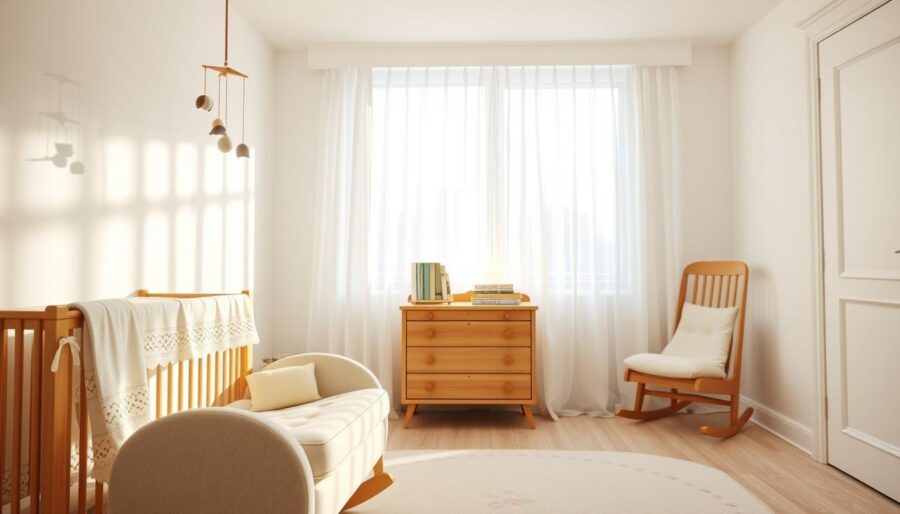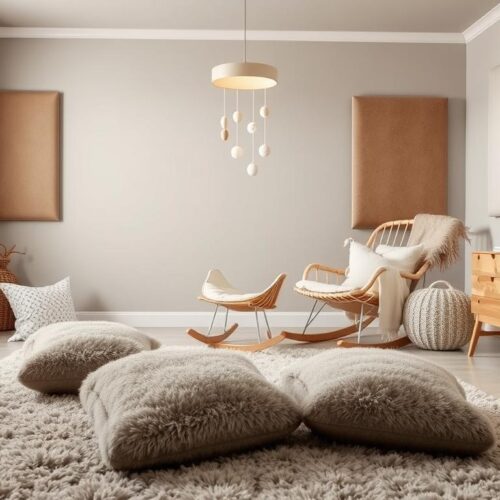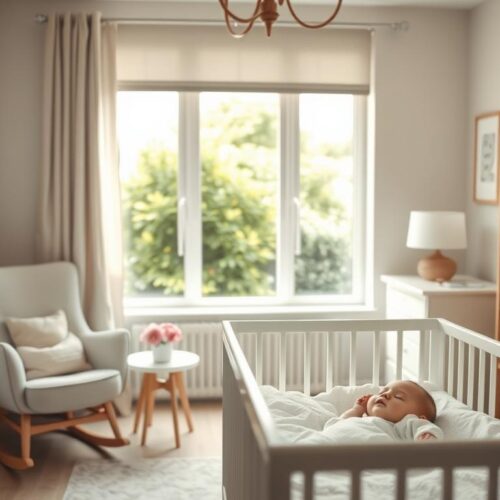Making a nursery peaceful is very important for parents who share a room for their babies. A quiet room helps babies sleep better and relax. This is vital for their well-being.
Sharing a nursery might be a necessity or a choice. Either way, keeping it calm takes some planning. Using certain design tips can create a peaceful space for both babies.
Benefits of Shared Baby Rooms
Room sharing for babies and parents brings many benefits. One top advantage of a shared nursery is ease for parents. They can care for their baby’s nighttime needs without going far. This close distance means more sleep for everyone.
Also, sharing a room boosts the emotional bond between parents and babies. Being close in a shared sleep space makes babies feel safer. This connection is key in their early growth.
Shared rooms help babies and parents sleep better, too. They can sync their sleep patterns. This makes setting a routine easier. Plus, parents notice their baby’s sleep signs sooner, helping them act fast at night.
For those worried about safety, room sharing is safer. The American Academy of Pediatrics (AAP) says it cuts the risk of sudden infant death syndrome (SIDS) by up to 50%. This is why many health experts urge parents to share a room with their baby.
Lastly, sharing a room is smart and saves money. It means there’s no need for an extra nursery. Families can use their space better without extra costs.
Setting Up the Perfect Shared Baby Room
Creating the ideal shared baby room is all about planning. The layout must focus on being safe and easy to get around. Make sure there’s enough room for cribs and changing areas, and arrange them for easy nighttime access.
Storage is key in a shared nursery. Choose furniture that has more than one use, like a dresser that’s also a changing table. Floating shelves can also help keep things tidy by using wall space. The aim is to make the room both comfortable and efficient.
Choosing the right colors is important too. Soft, neutral colors make the room feel calm. Yet, adding some bright colors can give it personality. Make the room special for each baby to help them feel they belong.
Good lighting matters as well. Dimmable lights let you change the mood easily, especially at night. Use blackout curtains to keep the room dark when it’s time to nap.
To sum up, a great baby room balances practical needs with comfort. Think carefully about the layout, storage, colors, and lighting. This way, you’ll make a beautiful room that’s good for your babies’ well-being.
Managing Sleep Schedules
Getting toddlers and babies to sleep in the same room needs a good plan. Creating a sleep routine for shared rooms helps them sleep well together. Here are a few tips:
- Consistent Bedtimes: Set a regular bedtime that fits your kids’ sleep needs to help them rest at the same time.
- Pre-Bedtime Routine: Calm activities like a soothing bath or reading a story let both toddlers and babies know it’s time to sleep.
- Gradual Adjustments: If your baby’s sleep time is very different, slowly adjust it. This helps match up their sleeping schedules with your toddler’s.
A well-planned sleep routine makes life easier. It leads to better sleep for both toddlers and babies. This way, everyone lives more in harmony.
Shared Rooms and Noise Control
Living together means finding ways to keep things quiet, especially in baby rooms. Using good noise control can make a big difference. It helps everyone get along and creates a peaceful space.
Putting furniture like closets or bookcases in the right places can block noise. This makes shared rooms quieter. Adding heavy curtains and carpets also helps take away sound.
Using white noise machines or special curtains that block sound is another great idea. They help keep outside noise from coming in. This makes the room calmer for everyone.
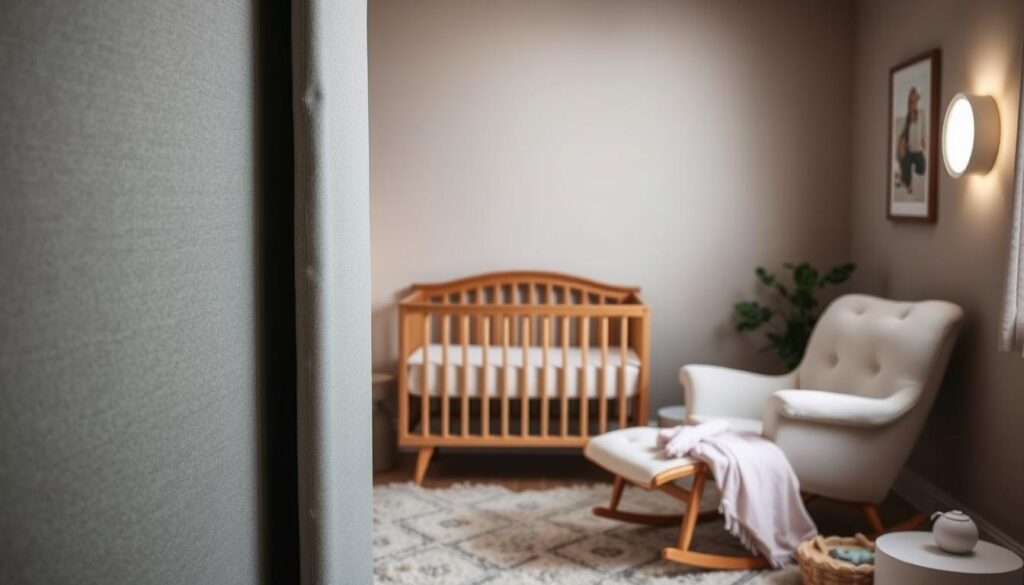
These steps help make shared living spaces much quieter. It’s important for everyone, especially babies, to have a peaceful place. Good noise control makes shared rooms better for everyone.
Soundproofing Shared Spaces
Creating calm spaces for babies requires knowing how to soundproof rooms. It’s important for a peaceful sleep and play area. Effective sound insulation in a shared bedroom can lower noise. This makes for a more serene environment.
There are many ways to improve soundproofing in shared spaces. Heavy curtains help a lot. They block light and soak up sound, making things quieter. You can also use weather stripping around doors and windows. This seals off gaps that let sound in.
If you’re up for bigger changes, try adding acoustic panels to walls. They come in different styles and colors, making them easy to fit into your decor. Thicker carpets or rugs with soundproofing below are also smart choices. They muffle footsteps, reduce noise, and make the room cozier.
Adding soft things like cushions, bean bags, and soft toys helps absorb sound too. Putting bookshelves and storage by shared walls can block more noise.
Knowing how to soundproof can give babies a peaceful room to share. By using these tips, kids can sleep well without noise from outside or each other’s activities disturbing them.
Leverage Architectural Features
Adding architectural noise control to shared baby rooms can make them much quieter. You don’t need big changes to your home to do this. Just use what your house already offers. This way, you can cut down on noise and make a calm area for your babies.
- Wall Insulation: Good insulation keeps noise from moving between rooms.
- Window Treatments: Heavy drapes or soundproof curtains help by soaking up sound and cutting down outside noise.
- Flooring Solutions: Carpets or rugs on the floor can muffle sounds and lower echoes.
- Built-in Shelves: Shelves full of books help block sound, soaking up noise.
| Feature | Benefit |
|---|---|
| Wall Insulation | Reduces noise transmission between rooms |
| Window Treatments | Diminishes external noise |
| Flooring Solutions | Softens sound and mitigates echoes |
| Built-in Shelves | Absorbs sound waves effectively |
Using these architectural elements, you can achieve better noise control. It turns your baby’s room into a quiet place. They can sleep well with less noise. Try these methods to improve sound control in your home.
Effective Bedtime Routines
Having a consistent bedtime routine is key for kids to sleep well. It helps them know when it’s time to sleep by giving them comfort and predictability. Doing calm activities like reading or singing a lullaby can relax your child and show it’s bedtime.
To make bedtimes smoother, try these tips. Dimming the lights and talking softly can help your child wind down. Also, sticking to the same sleeping and waking times can set a sleep pattern for your child.
These methods can turn bedtime into a calm, happy time for you and your child. It’s all about finding a routine that fits your family, ensuring your child gets plenty of rest.
Space Divider Solutions
Bedroom dividers for kids can change the game in shared rooms. They offer privacy and help organize the space well. When kids share a room, having their own areas makes everything peaceful.
There are many types of bedroom dividers, like folding screens, curtains, and bookshelf partitions. They are affordable and easy to set up. This makes them great for DIY lovers and those who want professional setup.
| Divider Type | Material | Ease of Installation | Cost |
|---|---|---|---|
| Folding Screen | Wood/Metal | Easy | Medium |
| Curtains | Fabric | Easy | Low |
| Bookshelf Partition | Wood | Moderate | High |
| Sliding Panels | Wood/Glass | Moderate | High |
Each divider has its plus points. For instance, folding screens are easy to move and bookshelf partitions offer extra storage. Choosing the right divider makes creating personal spaces easy. It gives kids their special spots for fun, study, or rest.
Dual-Use Furniture
When you’re designing a shared baby room, dual-use furniture is super helpful. It’s a smart way to use your space well and keep things neat and cozy. Using furniture that has more than one use helps save space in shared rooms.
This reduces clutter and makes the room more peaceful.
For example, a crib that turns into a toddler bed is practical. It grows with your child, so you don’t have to buy more. Another cool idea is a bureau that’s also a changing table. It saves floor space and keeps what you need close by. This makes your daily routines easier and less stressful.
Want more dual-use furniture ideas for shared baby rooms? Here are some:
- Bookshelves that separate areas and store items.
- Benches with storage under them are great for toys or bedding.
- Fold-out desks save space because they hide when not in use. This means more room to play.
These smart furniture choices meet your children’s needs now and as they grow. Investing in multipurpose furniture saves space and is a wise decision for shared rooms.
Sound Absorbing Materials
In a shared baby room, keeping the noise down is key to a calm setting. The right noise-lowering materials can make the nursery much quieter. Start with thick carpets and rugs, as they’re great for absorbing sound.
Acoustic panels are another good choice for shared rooms. They can go on walls or ceilings to lessen echo and noise. Felt, cork, and foam are top materials for these panels because they block a lot of noise.
Heavy curtains made from materials that absorb sound can cut down outdoor noise as well. Adding upholstered furniture also helps quiet down the room even more.
Here’s a look at common noise-reducing materials:
| Material | Average Noise Reduction (dB) |
|---|---|
| Cork | 30 |
| Felt | 25 |
| Acoustic Foam | 50 |
| Thick Carpets | 20 |
Mixing different materials is best for a peaceful nursery. From soft furnishings to special acoustic panels, these choices will make the room better for babies.
Creating Functional Nooks
Turning shared spaces into nursery nooks is a smart move for parents. It’s about making every inch count while keeping things comfy. Whether it’s a tiny corner in a shared room or just a special spot for your kids, these nooks can make a big difference.
Think about what your kids need. It might be a quiet corner for reading, a cozy sleeping area, or a place just for playtime. With those needs in mind, you can transform a small shared space into something amazing.
- Reading Nook: Create a peaceful reading area with a comfortable chair, a bookshelf, soft lighting, and cushions for extra coziness.
- Sleeping Area: Use themed beddings and elements like a canopy or curtain to make a private sleeping nook in a shared room.
- Dedicated Play Space: Keep toys and activities in bins and shelves for easy access. Decorate with fun rugs and bright colors to make it inviting.
To bring these ideas to life, check out the table below for layouts and key features:
| Type of Nook | Key Features |
|---|---|
| Reading Area | Comfy chair, bookshelf, cushions, soft lighting |
| Sleeping Spot | Thematic bed linens, curtain or canopy, comforting elements |
| Play Space | Toy bins, organizing shelves, playful rugs, colorful decorations |
When you design nursery nooks that meet your child’s needs, you utilize small spaces smartly. You also help your child feel they have a place of their own.
Developing Noise Prevention Strategies
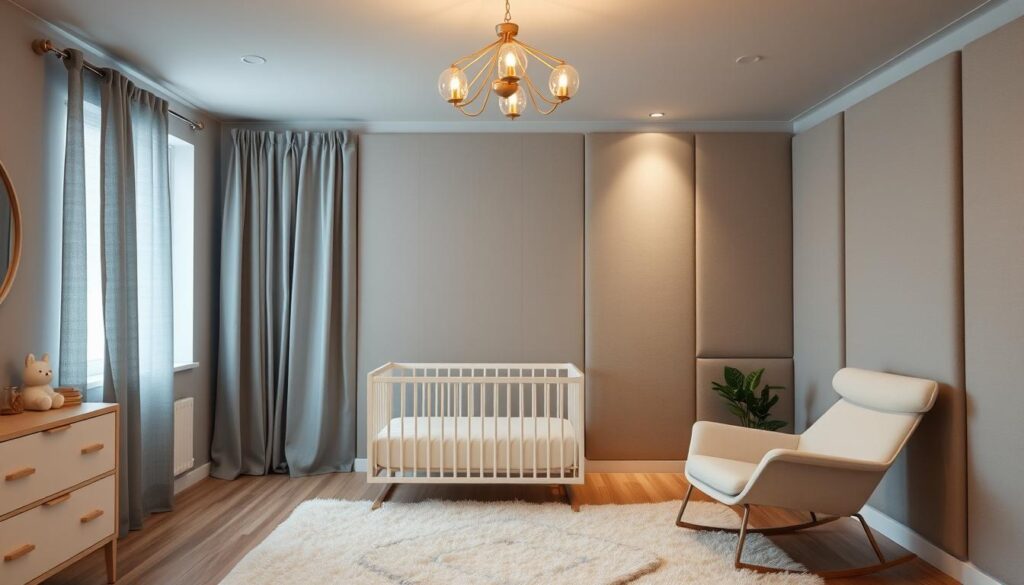
Creating good strategies for proactive noise management for nurseries is key for a peaceful setting. We start by pinpointing the main noise challenges in places like shared baby rooms.
- Identify Noise Sources: Determine where noise is coming from and find ways to mitigate these sources.
- Use White Noise Machines: Utilize white noise machines to mask disruptive sounds and provide a calming background for babies.
- Install Soft Flooring: Carpets and rugs can absorb noise, effectively reducing the sound that travels through the rooms.
By introducing proactive noise management for nurseries, we improve sleep quality and create a quiet atmosphere. This ensures that shared spaces are great for both rest and play.
Personalizing Sleep Spaces
Making your kids’ sleep area special is key to them feeling happy and secure. For kids sharing a room, give each one their own space. This lets them know they’re important. Do this with their own bed linens, wall decorations, and places to put their things.
Adding things that show what each kid loves makes their space even better. Pick themes that go well together but still let each child show who they are. Say one kid adores stars and another the jungle. You can choose colors that work for both interests.
| Element | Customization Ideas |
|---|---|
| Bed Linens | Choose patterns that reflect each child’s favorite colors or characters. |
| Wall Art | Personalized name plaques, mural wall stickers, or favorite quotes add a personal touch. |
| Furniture | Opt for dual-use furniture to maximize space and functionality. |
| Storage | Custom labels or unique bins/hooks can help keep each child’s belongings organized. |
Unique lights can make a big difference, too. Their own lamp or a fun nightlight adds to the room’s look and helps with bedtime. Getting your kids to help design their shared space makes them feel part of the process. It builds a loving and creative atmosphere at home.
Conclusion
We’ve learned a lot about shared baby rooms. Planning carefully is key. It’s about mixing smart design with effective sound control solutions.
For a quiet nursery, think about soundproofing and using materials that block noise. This helps your babies sleep well.
Every family is different. So, shared baby rooms should fit your specific needs. Use furniture that serves more than one purpose and divide the room smartly. This makes the room work better and feel comfy.
Also, a good sleep routine is important in shared rooms. It helps keep things calm.
In the end, our goal is a calm space for our kids. Adding personal touches makes the room special. Along with noise control, we aim for a safe and cozy spot for our children. It’s all about balance and peace.

